
Equipment
Truck Checks: Transmission tips – part 4
This is the final instalment in our series on transmissions. You can find the previous columns at www.firefightingincanada.com (click on Past Issues)
September 17, 2008
By Don Henry
This is the final instalment in our series on transmissions. You can find the previous columns at www.firefightingincanada.com (click on Past Issues).
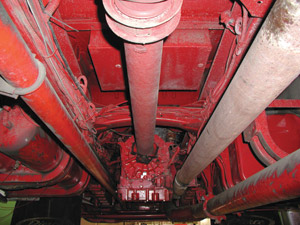
The drive shaft looking toward the transmission/engine; check the u-joints.
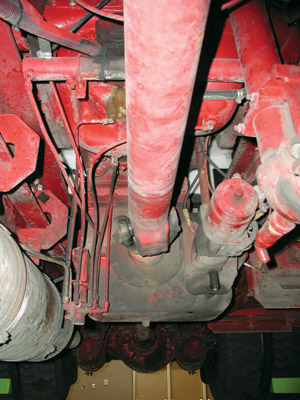
Drive shaft looking to rear of truck; check the u-joints. Advertisement
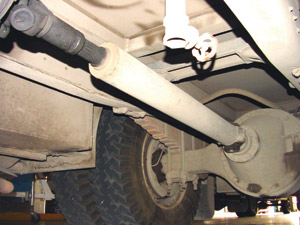
A typical problem: a drive shaft with the u-joints out of phase. This truck had bad vibrations at between 40 and 55 km/h. 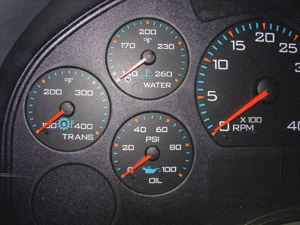
A newer-model truck with the multiplex electrical system. The transmission oil temperature gauge is at the lower left. 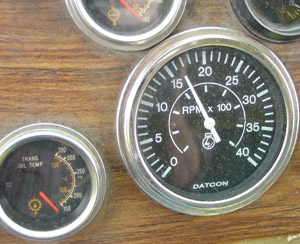
This r.p.m. gauge shows a low stall speed for this unit. It should have been 1,800-1,850 r.p.m., not less than 1,700. A simple valve, injector tune up fixed the problem. |
Stall test
A stall test should be conducted when there is concern about the performance of the engine and/or the transmission.
Before conducting a stall test, ensure that the transmission oil level is correct. An incorrect oil level will cause the oil to foam. The foamed oil will contain air bubbles and will result in incorrect test results.
Ensure that the engine and transmission are at operating temperature between 160 and 200 F (71 and 93 C). Place the truck in an open area and warn everyone of the test. Block the wheels and apply the parking brakes (spring) and the service brakes (air).
Inspect and determine that the drive shaft and U-joints are able to withstand the load that will be placed on them. (See photos 1, 2 and 3.) Replace any defect U-joints before the stall test.
Prove that the engine tachometer is accurate. Place the transmission in neutral and push the foot throttle all the way to the floor. This r.p.m. number must be the same as the published ULC number on the fire pump test certification plate, plus or minus 50 r.p.m.
If this r.p.m. number is not correct, stop the test and find out why. Some books will call this high idle, max r.p.m. or governed r.p.m. Place the transmission in the highest range possible; this means selecting D for drive. Never select low gear (D1) or reverse.
With the brakes firmly applied, increase the engine speed with the foot throttle to wide-open throttle (WOT). The engine should speed up until it reaches its correct stall speed; this r.p.m. should be safely recorded. The stall test should not be conducted for more than 30 seconds. It will normally take less than 30 seconds for the r.p.m. to stabilize.
During the test, obverse the temperature of the transmission oils with the gauge on the dash. Never allow the temperature to rise above 300 F (149 C) during the test. It is normal for the temperature of the oils to rise very quickly. (See photo 4.)
What r.p.m. should the stall speed be? When your truck was manufactured, the builder took into account engine power transmission gear ratio, rear axle gear ratio, tire size, top speed and the terrain at which the vehicle would have to work. It was important that the correct engine, torque converter and transmission were selected to allow the engine to reach near its peak engine torque. Only the people who made your truck can give you the correct r.p.m. stall speed. This r.p.m. is lower than the engine maximum governed speed.
For example, the stall speed of a common truck engine may be 1,700 r.p.m. with the maximum governed speed at 2,300 r.p.m. By selecting the correct combination you get a truck that can pull away from a standing stop and accelerate to its top speed as fast as possible without damaging driveline components. (See photo 5.)
It is the job of the torque converter to multiply engine torque. The engine turns the torque converter impeller at whatever engine speed is. The torque converter causes flow of transmission oil and this oil is pumped from the impeller to the torque converter turbine. The oil must now be redirected back to the torque converter impeller wheel and this is the job of the stator.
The stator is located between the impeller and the turbine wheel at the inner circle. During hard acceleration, the stator will lock (not be allowed to rotate). This is necessary for the multiplication of engine torque because of the redirection of the oil. The locking is accomplished by a one-way, over-running clutch (also called a sprag clutch). If this clutch were to fail, there would be no multiplication of engine torque. A normal stall speed of say 1,700 r.p.m. would fall by approximately one-third to 1,200 r.p.m. and the driver would complain that the engine had no power when accelerating.
At the end of this stall test, the transmission oil will be very hot and must be cooled. Slow the engine to the idle speed and place the transmission in neutral. Accelerate the engine to between 1,000 and 1,400 r.p.m. You should see the transmissions oil temperature rapidly decrease. This part of the test is called the cool down. If the oil does not cool down, then the oil cooler may be plugged or the one-way clutch in the stator could be stuck and may not be free wheeling. This will prevent the transmission oil from cooling properly.
The cool-down test and its results are just as important a diagnostic tool as the r.p.m. stall test. Many transmissions are ruined because of overheated oil, so the condition of the oil cooler is very important. As most transmission oil coolers use the engine coolant system to remove heat from the transmission’s oil, any problem with the engine’s coolant system will affect the transmission. Low coolant level, poor quality coolant or a defective thermostat(s) will cause problems.
After a transmission rebuild, the oil cooler lines can get mixed up and connected to the cooler incorrectly. This will not cause an overheating problem right away but on the first hot day, on a trip with hard accelerations and hills, the transmission oil will begin to overheat.
Interpretation of stall test results
1. Above rated speed (or a high stall speed)
Let’s say that a normal stall speed for this truck is 1,700 r.p.m. If your results are more than 150 r.p.m. above the normal r.p.m. and the oil level is found to be correct, then you most likely have a defective clutch pack. This could be caused by low clutch pack oil pressure or possibly, a broken clutch pack seal.
Check the transmission operating main pressure and see if it is lower than normal.
Avoid the use of transmission oil additives that are advertised to swell the clutch pack seals. While this may be quick automotive fix, it’s not what you want for your fire truck.
When in drive and at the curb conducting a stall test you must remember that you have only charged two clutch packs, and, as such, a stall test only tells you the condition of those clutch packs. The other clutch packs that are involved in the other forward ranges can be checked by driving the truck, or by using the Allison diagnostic laptop computer program. If you have a defective clutch pack in, say, third range then you must look at the clutch packs involved in that range. As you know the forward clutch pack is good from the stall test, then the defective pack must be the clutch pack used in third range.
How will you know you have a problem? When the transmission up-shifts from a lower range to a higher range you should see the engine r.p.m. drop and then slowly climb again during a normal acceleration. If the r.p.m. instead increases very quickly and the truck does not move forward at the same rate, then you have a flare. This flare is caused because of a slipping clutch pack. To be in any forward or reverse range you must have two clutch packs engaged. If this happens (and it would be rare to have a clutch slip) you will become quickly aware of the problem – the large clouds of smoke and burning smell will be the giveaway. The transmission oil will be black and have an overheated smell to it.
2. Lower than normal speed (or low stall speed)
If the recorded stall speed is 150 or more below the normal speed your problem is most likely in the engine. If the engine has a lot of black exhaust smoke, suspect a plugged air filter or a defective fuel injector. If there is not excessive smoke then look at a plugged fuel filter. You could have a defective turbocharger or a crack in the air-to-air cooler that is in front of the radiator. It could be just as simple as the fact that this engine needs to have its exhaust valves, intake valves (if it has them) and injectors adjusted. Keep in mind that modern electronic diesel engines normally generate very little smoke.
Stall speed substantially lower
The stall speed will be 30 to 50 per cent below normal stall speed. A defective freewheeling stator almost always causes this condition. The complaint will be that the engine has no power when, in fact, the torque converter is not multiplying the engine torque.
Talk to the operators. They will most likely tell you that sometimes, if you start off slowly, the truck works fine, and at high speed it works fine.
Get on this right away; at this point it can be a fairly inexpensive repair. You may need to only install a new over-running clutch if no other damage has been done. If this condition is allowed to continue, it has been my experience that the one-way clutch may pile up inside the torque converter. This will cause the stator to stick. The torque converter will multiply torque but the transmission oil will overheat fast and the transmission will be ruined. You will hear the operators say the transmission cured itself (be very worried if you ever hear anything mechanical cured itself) and the next minute the transmission oil is very hot and smells burned. It has been my experience that the greatest cause of a defective stator is the driver backing up the truck and placing the it in forward before the truck comes to complete stop. Tell the drivers to use the large black things on the ends of the axle called brakes to stop the truck before changing direction.
The stall test should not be done as part of a daily or weekly check; it needs only to be done if a performance complaint is received, or make it part of an annual check. It can sometimes be difficult to obtain the stall speed specification r.p.m. years after the truck has been made, so make sure you demand this information as part of the bid process and store this number with the transmission’s SAM number. On some newer electronic engines it may be necessary to have the truck moving forward before you start the stall test. If you do not feel confident to conduct a stall test, then your local Allison dealer will.
Don Henry teaches in the Automotive Service Technician and Heavy Equipment Technician programs at Lakeland College in Vermilion, Alta., where he has been a faculty member for more than 17 years. He has co-developed and delivers Canada’s only post-secondary level fire-apparatus maintenance program and has completed a textbook on fire apparatus.
Print this page